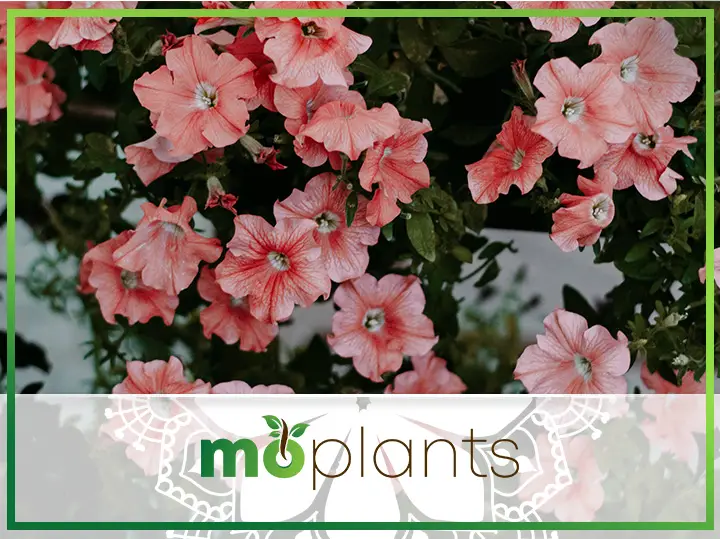Petunias take the crown for being one of the most beloved garden flowers in most parts of the world. The delicate trumpet-shaped blooms paired with the bright hues of these annual flowering plants can boost the curb appeal of your home, adding a splash of color to an otherwise plain exterior.
You can find petunia flowers in alluring shades of purple, pink, red, orange, yellow, green, and white. While some varieties of this flowering plant produce single blooms, the others boast double blooms. Similarly, some petunia flowers feature ruffled petals in solid colors, whereas others may have smooth petals with multi-colored variegations.
Interestingly, most of the gardening varieties of petunias today are hybrid of two particular species: Petunia integrifolia and Petunia axillaris. Native to South America, these species are rather popular among plant breeders as they allow the experts to create new and attractive varieties of petunias with multi-colored blooms.
Unlike most other flowering plants, petunias are easy to transplant and look after. Despite their stunning appearance, these plants are neither dramatic nor high-maintenance. However, if you are looking to grow petunias, consider planting them in spring once the threat of frost has passed.
Here is our detailed guide on growing and taking care of petunias to ensure they keep blooming.
Introduction: Petunias
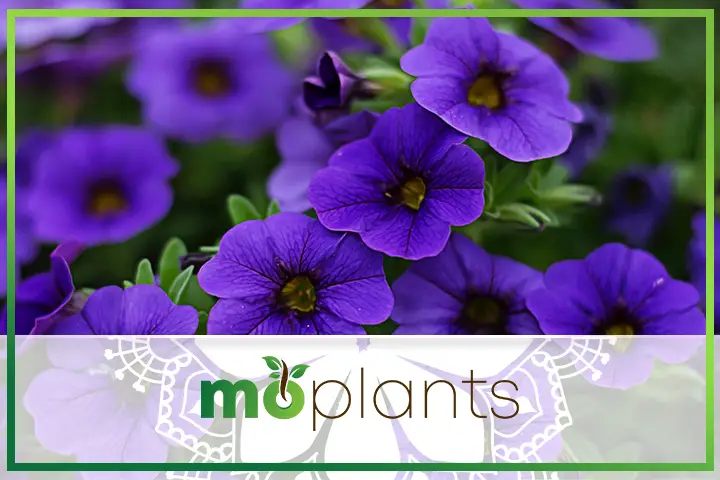
A genus of 20 flowering plant species, petunia is a member of the Petunioideae subfamily in the larger Solanaceae family – also known as nightshade. Some other members of the wide-ranging family include tobacco, eggplant, potato, and chili pepper.
Though petunias are known as annuals, they can last several seasons in warm climates. They are native to South America and can produce flowers throughout spring, summer, and fall. Morever, these dazzling flowering plants grow well in USDA zones 10 and 11.
Typically, the compact and bushy varieties of petunias are grown outdoors in flower beds. Meanwhile, the trailing varieties of the plant can create an enchanting aura when planted in window boxes or containers. You can also place these cultivars in hanging baskets so they can flow down the edges and add an element of interest to your patio or terrace.
You might also be glad to know that one can even grow petunias indoors. The plant will remain healthy and continue to bloom as long as you ensure it receives adequate sunlight and care.
Furthermore, the size of petunia plants varies with each cultivar. The compact varieties usually grow between six to 12 inches tall, while others may reach the height of up to three feet. Some types of petunias can also grow as tall as 8 feet. On average, these plants have a width of one to four feet. They mostly feature branching foliage with wide flowers in a distinctive trumpet shape. Some cultivars are even fragrant.
In addition, you can find these flowers in a range of hues except true blue.
There are four main species of petunias, each of which has dozens of cultivars.
- Grandiflora petunias: This species produces three to five-inch blooms that grow upright. However, as the plant matures, the foliage and flora may spill over the side of the container.
- Multiflora petunias: These flowering plants feature smaller yet more abundant blooms. They are also more tolerant of wet conditions and are considered to be fast growers.
- Milliflora petunias: They are a miniature version of petunias, known for their compact appearance. Their flowers are only about an inch wide, though they can last all season.
- Spreading petunias: Also known as trailing petunias, these flowering plants are low growers and can rapidly take over an entire area with their eye-catching foliage. They can grow up to six inches tall.
How to Grow Petunias
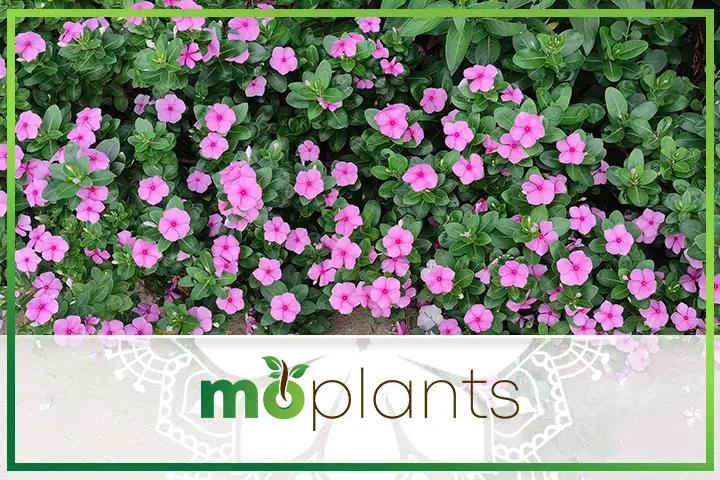
Here are some tips on how to grow petunias to create a more vibrant landscape.
Planting and Placement
There are many ways to grow petunias in or around your home. For starters, you can plant them in window boxes or raised beds so the branches can cascade over the sides of the container to create a fuller appearance. Alternatively, you can densely plant petunias in your garden where they can cover as much ground as possible. You can also mix them with other flowering plants for a dazzling view.
If you are a fan of trailing petunias, tucking them into hanging baskets may be a great idea. To ensure the plant receives sufficient sunlight, you can hang these baskets inside your home in front of the window.
Ideal Temperature
Petunias enjoy warm weather. Whether they are outdoors, please remember that they thrive in temperatures between 60 and 70 degrees Fahrenheit during the day. At night, they prefer temperatures between 55 to 65 degrees Fahrenheit.
It is also worth mentioning that extremely cold weather and freezing temperatures can kill petunia plants. Therefore, consider moving them to a warm location or set a cover over the flower bed.
Humidity Level
These striking flowering plants do not thrive in highly humid environments. Low to moderate humidity is usually enough to keep the petunias alive and healthy for the entire season.
Exposure to Sunlight
Petunias love the sun. They need at least five hours of bright sunlight, so it would be best to plant them in a location that receives full sun throughout the day.
However, these plants don’t fare well in extreme weather conditions. Hence when the temperatures begin to soar, you may want to provide a partial cover to your gorgeous petunia flowers to keep them fresh and effervescent.
Watering Frequency
If you are new to the world of gardening and haven’t taken care of a plant before, you will be glad to know that petunia plants are relatively drought-tolerant. In other words, they won’t die even if you forget to water them occasionally.
Although petunias don’t like soggy soil, they also don’t prefer dry conditions. Therefore, you should water the plant only when the top two inches of the soil have completely dried out. Usually, watering your houseplant once a week is more than enough.
Moreover, refrain from watering the plant too often as it may result in root rot.
Potting Mix
Petunias perform their best in slightly acidic soil that has good drainage properties. To ensure your plant grows healthy and strong, you can purchase light and fertile soil from a nearby nursery or gardening center.
Infographic
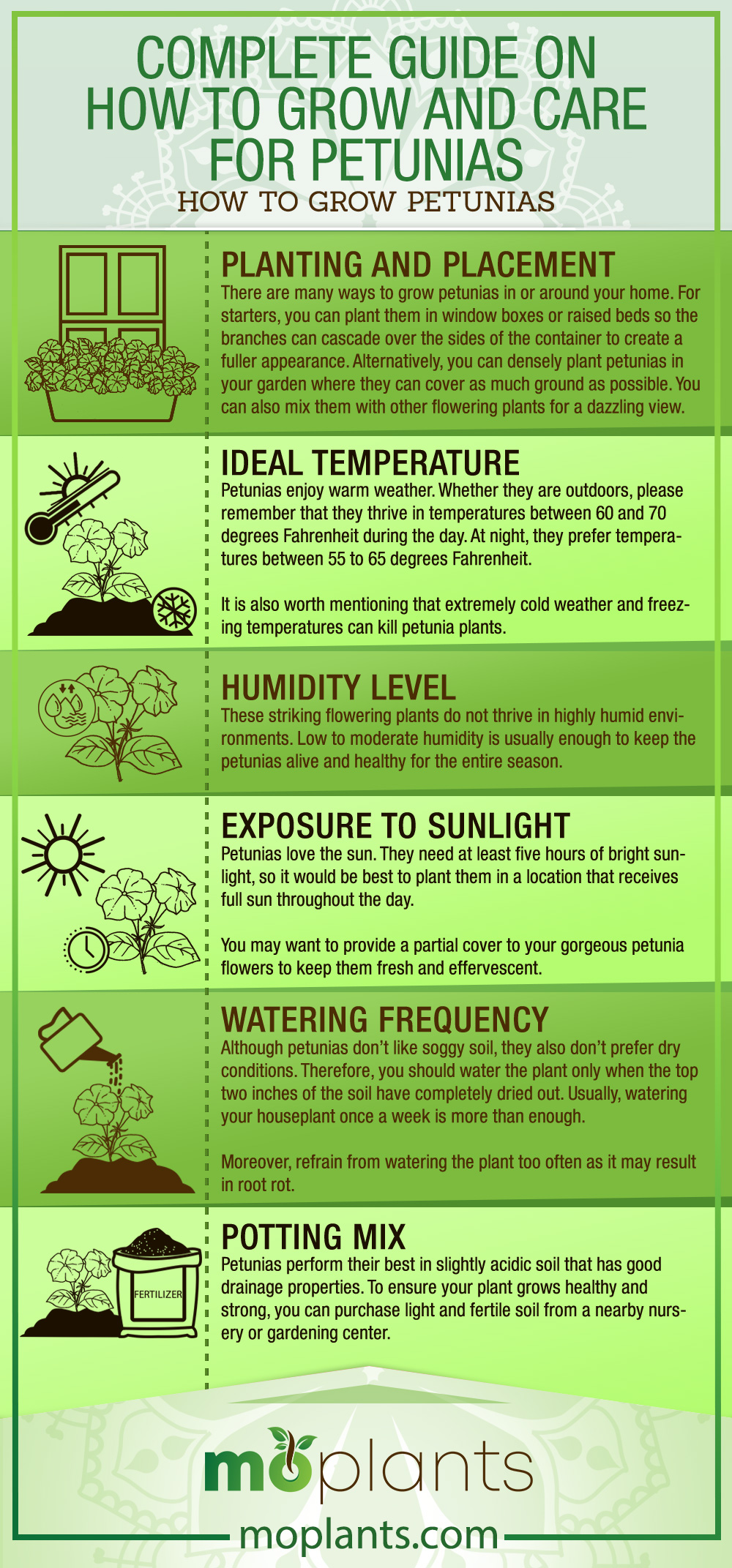
How to Grow Petunias from Seeds
While most people prefer buying young petunia plants and replanting them in their home gardens, others take the slightly more challenging route by growing petunias from seeds.
Petunia seeds are tiny and take a long time to mature. Therefore, it is recommended to start your seeds at least 10 to 12 weeks before the frost begins to set in.
You can spread these seeds on top of a moist potting medium and gently press them down into the surface to cover them with the soil but can still receive ample sunlight. You can use clear plastic to cover the container and put it in a warm spot that receives indirect light.
It will take about ten days or so for the seeds to germinate, after which you can remove the plastic cover and allow the seedlings to produce leaves. Once you can see at least three true leaves, it’s time to transplant petunias into an indoor container or a flowering bed outdoors.
Petunia Care Tips
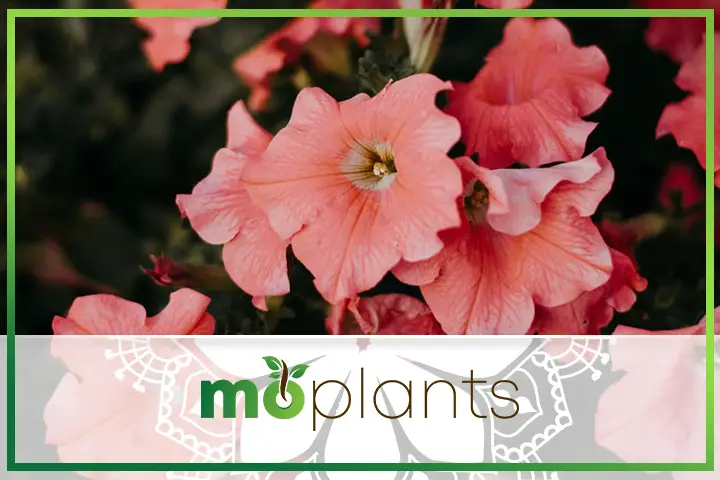
The remarkable aesthetic beauty of petunias makes them one of the best flowering plants to grow indoors and outdoors alike. Although they are easy to look after, here are some petunia care tips that all home gardeners must know about.
Pruning
If your petunia plant looks leggy, it might be time to cut back the branches to encourage new growth that will result in a fuller plant.
It would be best if you considered cutting the stems by a quarter or a half, depending on the condition of your plant. However, before you begin, make sure to clean and sterilize your knife or scissor to reduce the risk of infections.
Deadheading
It is essential to remove dead flowers from your petunia plants throughout the growing season. This practice will ensure the foliage and flora look beautiful while tricking the plant into producing more flowers.
While deadheading petunias, make sure to remove all parts of the dead flower. In some cases, you can leave the stem behind. Ideally, you should follow this petunia care tip once or twice a month at most.
Fertilizing
When it comes to petunias, each species and cultivar may have slightly different feeding requirements. Hence, it would help if you considered adding a balanced fertilizer to the soil when planting your flowering plant. As the plant begins to grow, you can feed it a suitable liquid fertilizer every three weeks so it can bloom quickly.
Please note that some trailing petunias may need weekly nourishment. Therefore, it is crucial to learn about the type of petunia you have planted in your home or garden to determine how often you should feed it.
Repotting
If you are growing your petunias in a container and have noticed that they are becoming root-bound, please purchase a new pot that is a size bigger than the current container and get ready to repot the plant.
Since petunias are rather delicate, it would be best to gently shake the container and then tip it to the side so the plant can slide out. Also, please leave the dirt on the roots and position the plant in the new pot filled with small pieces of gravel at the bottom.
Next, add a fresh potting medium to the pot to fill up the gaps. You can also lightly press down the soil before watering it thoroughly. Once you have moved the plant to a sunny location, keep an eye out for soil setting and add more potting medium as required.
Pro Tip: If you plan to move your petunia plant from indoors to outdoors, help it get acclimated to its new environment by moving the pot to its new location for a few hours every day. Doing so will prevent your beloved plant from going into shock.
Are Petunia Flowers Toxic?
No, petunias are not toxic. Though they are also not edible flowers, ingesting them is unlikely to cause any harm to humans and pets alike. However, if your toddler or furry companion consumes a large quantity of this flowering plant, they may experience stomach aches and vomiting.
Common Petunia Problems and How to Solve Them
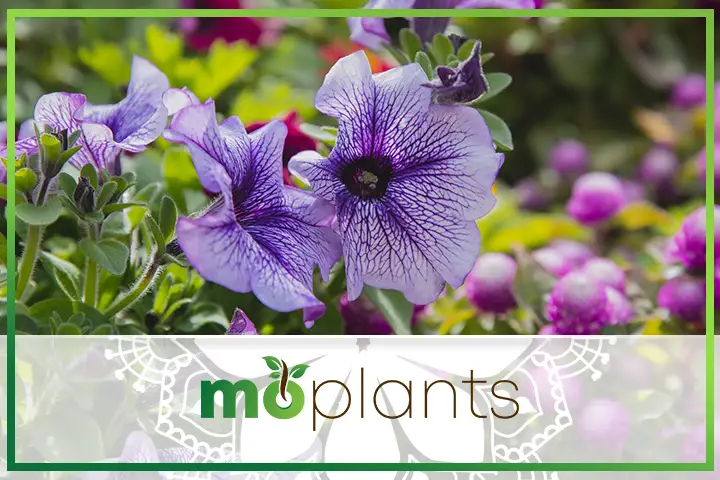
Let’s look at some of the most common problems you may encounter while growing petunias and tips on fixing them.
Wilted Plant
If the leaves or flowers of your plant have begun wilting, it may mean you are under or overwatering them.
To find the culprit, touch the soil to determine if it is wet. If the top two inches of the potting medium hold no moisture whatsoever, please make sure to water your petunias as soon as possible. On the other hand, if the soil feels soggy, move the pot to a sunny location and cut back on watering.
Leggy stems
There are three main reasons your petunias may have become leggy: insufficient light, dry soil, and lack of nutrition.
To troubleshoot this problem, prune the foliage and deadhead flowers to encourage bushier growth. It may also be a good idea to feed the plant at least once a month and water it weekly to ensure a healthier appearance.
Common Pests and Diseases
Petunias are susceptible to aphids, slugs, flea beetles, and snails, among other common pests. Usually, you can deter these bugs by washing the plant. In addition, you can use insecticidal soap to get rid of heavy infestation.
Some varieties of petunias may also develop fungal infections during rainy seasons. So, if you live in an area that receives heavy rainfall, consider planting cultivars that prefer moist conditions.
Infographic
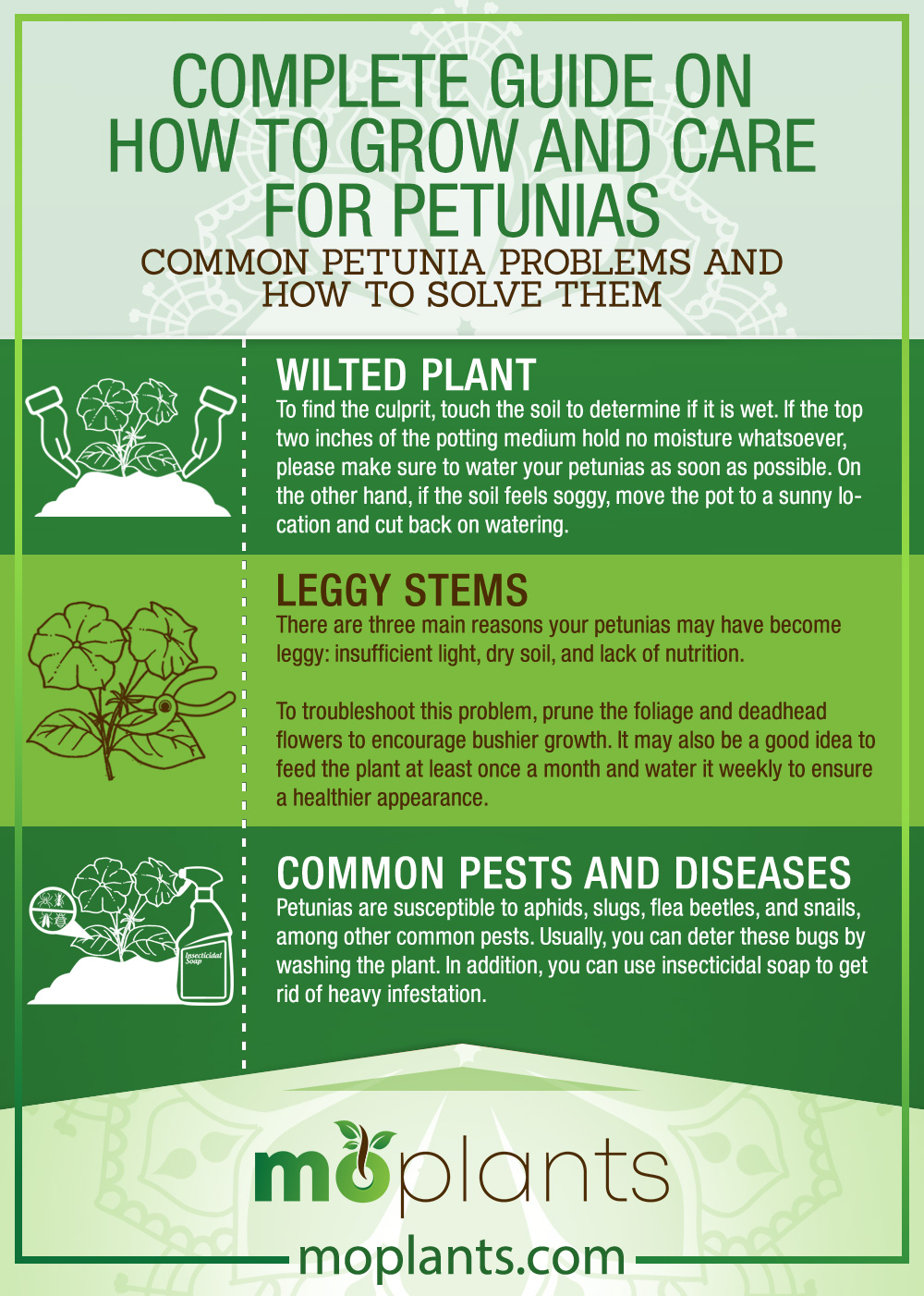
Popular Types of Petunias
These are some of the most popular types of petunias that can add to the aesthetic appeal of your home.
Grandiflora Petunia Varieties:
Some of the most revered types of Grandiflora petunias include:
- Supercascade
- Super magic
- Daddy
- Dream
- Storm
- Ultra
Multiflora Petunia Varieties:
Here are the most well-known types of multiflora petunias:
- Horizon
- Primetime
- Celebrity
Spreading Petunia Varieties:
Take a look at the top cultivars of spreading petunias:
- Shockwave
- Avalanche
Miliflora Petunia Varieties:
This type of Miliflora petunia is easily the most popular one out there:
- Fantasy
Petunia FAQs
Now that we know how to grow look after, and troubleshoot petunia plants, let’s answer some of your most pressing questions about this flowering beauty.
Do petunias like sun or shade?
Petunias prefer sun over partial shade. They need a minimum of five hours of good sunlight every day to produce healthy and vibrant flowers.
Why do petunias get sticky?
Petunia plants produce a mushy material that oozes out of their stem tissues. This substance is rather sticky and coats the soft foliage of the plant as it grows. According to the Utah State University Extension, this excretion protects petunia flowers and leaves against bugs.
How long do petunias last?
Petunias may be annuals in colder regions, but they can live up to three years in warmer climates.
To conclude, petunias are among the most beautiful flowering plants you can grow in or around your home. They can cascade down their container, so you may want to place them in hanging baskets or window boxes to create a mesmerizing effect while adding curb appeal to your property.
Moreover, petunias flourish in bright and direct light. However, they may require partial shade during extreme heat. When the winters roll around, you can cover your stunning flowering plant to ensure the freezing temperature doesn’t kill it. Furthermore, you must only water your petunias once the top of the soil is completely dry and feed them regularly to nourish the leaves and flowers.

